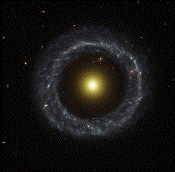
Astronomy
Chapter 3: Observing Lab

Astronomy Lab Instructions
Astronomy Lab: Observing the Moon
Goal: To observe the Moon
Materials and Equipment:
- Telescope, binoculars, and pinhole card
- Pencil, paper for notes and drawings
- Sky and Telescope
Preparation
- Check the current month's Sky&Telescope, Astronomy Magazine, or use Starry Night and determine when the following phases of the moon will occur next: New moon (moon between earth and sun), 1st quarter, full moon, 3rd quarter. Remember that from new moon to 1st quarter to full moon, the moon is visible in the evening (and interferes with deep sky viewing).
- Plan two viewing sessions of the moon at least 7 days apart.
Observing Session
For each of your two observing sessions, complete all of the following observations:
- As always, note the date and times of your observations, and the moon's position in the sky with respect to the horizon (for example, "in the south east, low") and with respect to the stars ( for example, "in the constellation Leo near Regulus").
- What stars is the moon near? Does it occult any background stars or planets during the night?
- Draw a naked eye picture of the moon showing its shape, and locating the darker areas. Where is the terminator (the line between the light and dark sides of the moon)?
- Look through your binoculars or telescope at the moon and make another drawing, showing the shape and dark areas. Compare the drawings: does the moon look the same in the telescope or binoculars as it does in with your own eyes? What is the orientation of the sunlight side (left or right)?
- Can you tell where the dark side of the moon is? Where does the light you see from this dark side come from?
- Is it easier to see craters on the brightly-lit areas of the moon, or near the terminator?
- Closely observe a large crater. Note anything interesting you see (is there a central spike? Smaller craters overlaying the larger one?)
- Closely observe a mare (flat dark region). Note anything interesting you see. (Are there rills? Mountains? Craters?)
- Find a map of the moon and use it with your telescope or binoculars to identify at least three large features on the moon (see if you can find Tycho!). Record your observations.
- If possible, identify two stars close to the Moon on either side, and draw a picture showing the relative positions of the moon and the two stars as accurately as possible. Look up their right ascension and declination coordinates (you can email mycroft if you need help doing this). Use the RA values to determine the angle between the two stars, then based on your drawing, estimate the angular diameter of the moon. How close is it to the "textbook" value of 31"05'?
- Always record any other observations you think interesting, even if they are not part of your current observation plan. The earliest report of Supernova 1987A was posted by an astronomer who had gone outside for a break from his southern hemisphere survey project, and who just happened to notice "something funny" in one of the Magellanic Clouds!
Report
Write a report of all your observations and post it to your thread in the Astronomy Forum at the Scholars Online Moodle Astronomy Page. Your report should include
- A list of the materials you actually used.
- A brief description of your procedure, with notes on any major changes you made to the suggested procedure above.
- The standard basic data about your session (see previous lab).
- Answers to the questions asked in my procedure directions, if they apply.
- Report any other observations you think interesting or important.
- Compare the appearance and positions of the moon between your two observing dates. Explain these differences in terms the changing position of the earth, moon, and sun.
© 2005 - 2024 This course is offered through Scholars Online, a non-profit organization supporting classical Christian education through online courses. Permission to copy course content (lessons and labs) for personal study is granted to students currently or formerly enrolled in the course through Scholars Online. Reproduction for any other purpose, without the express written consent of the author, is prohibited.